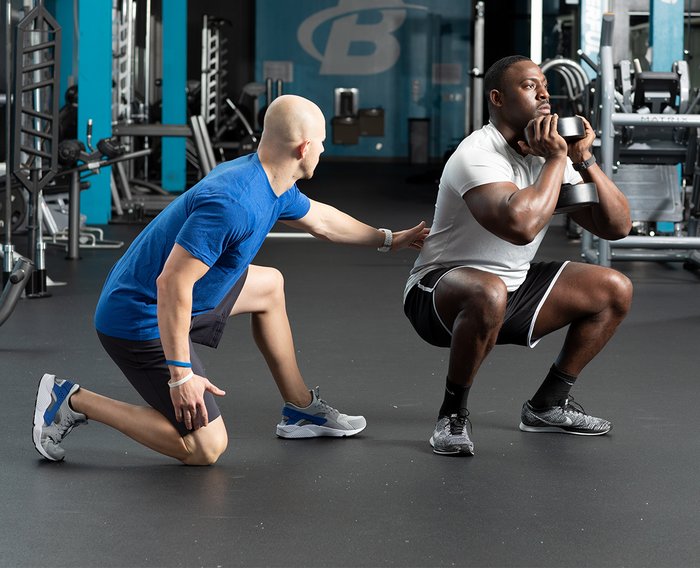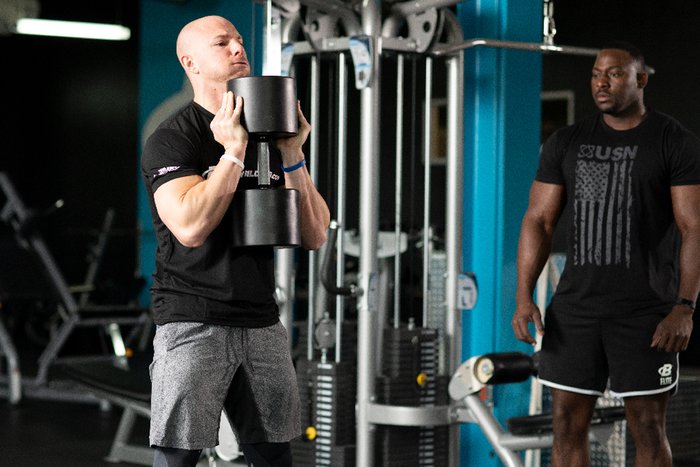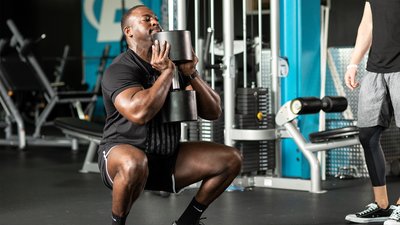When lifters hear the word "squat," their minds gravitate directly to one thing: the barbell back squat. But let's be real, squatting is not synonymous with throwing a bar on your back with a few wagon wheels on each side and going for broke. The squat is just a movement pattern—one with plenty of variations.
So, where do you start with it? Contrary to popular belief and practice, the barbell back squat is not the right starting point. As I explained in my article "The More Gain, Less Pain Guide to Squats," the back squat is the apex of all squat variations due to its loading capacity and complexity. But that doesn't stop damn near every recreational lifter from jumping straight to the barbell on day one. In my experience, there are a few key steps that must happen first to ensure the squat is learned right, and to unlock its incredible performance potential.
Instead of simply hoping you're good enough at squatting to use a barbell, try this: Use a single dumbbell instead, held in front of you with a goblet hold. And before you say, "That's too easy," well, I've got a quick protocol you must try, from my Bodybuilding.com BodyFit Elite guide Unstoppable: The Ultimate Guide to Training Through Injury.
It's not even a full workout, it's just one part of the Back-and-Knee-Friendly Lower-Body Workout. But it's also a sneaky and sinister test of your squatting ability, as well as your mental resolve.
Get ready. I'm throwing the gauntlet down, and it's up you to live up to the challenge.
The Goblet Squat Ramp-Up and Test
Goblet squat 5-7 sets of 5 reps, starting with 10 pounds and moving up in increments of 20 pounds, resting for 45-60 seconds between. Then, 1 set of 25 reps with half of your body weight.
Displaying Strength vs. Developing Strength
Here are the details: Start by performing reps of goblet squats with 10 pounds. I know you can do that. Then, you'll step up in 20-pound increments: 30, 50, 70…and so on until you hit the heaviest dumbbell you can handle for 5 reps, or you run out of weights. NPC bodybuilder and Bodybuilding.com athlete Reuben Brooks and I went up to 150 pounds, the heaviest bells in the Bodybuilding.com gym. Even if you can squat 300 pounds or more, trust me: that's no joke.

But guess what? It's just the appetizer. The main course is backing off to half of your body weight and performing 25 reps in a single unbroken set. That's your "test."
Here are the rules:
- Use a dumbbell or kettlebell that weighs 50 percent of your current body weight.
- Each squat must reach parallel depth.
- No ugly compensations at the spine, shoulders, hips, or feet allowed.
- Complete as many unbroken reps as possible, without resting at the top between reps, up to 25 reps.
As in any testing scenario, we must ensure that we properly implement the test for accuracy, but also use discretion. As soon as technique goes south and ugly reps start showing up, the test is over. Never jeopardize your health, or an athlete's health, for the sake of passing a test.
Why structure it this way? This extended ramp-up scheme allowed us to get more total volume into our training day with sub-maximal weights, which is a kind of loaded "practice" for optimizing the movement pattern itself. Consider it a functional warm-up to groove the squat pattern before you push it to the brink of your physical capacity.
It's important to note that this ramp up scheme will pre-fatigue you, limiting your performance on the goblet squat challenge itself. So, the goal of doing just the test is a bit different than doing the ramp-up and the test together. But for the average lifter who is looking to train hard and work this scheme into their leg day, I recommend both together, to add lots of quality volume to your lower-body training. Simply know that you won't be displaying your fullest potential in the goblet test, but rather, helping to develop it.
Having personally been using this 25-rep standard for years, I no longer "test" myself or my more veteran athletes, but rather treat it as lower-body accessory work, just the way it is in the video.

What the Goblet Squat Challenge Means
After putting many athletes through this exact test in my career, I need to warn you: Prepare yourself to be humbled. Even some of the strongest individuals are pushed to the brink of failure on this test.
The goblet squat test doesn't only test anathlete's lower-body strength and muscular endurance, it also identifies weak links in the foundational squat pattern that usually come to the surface when load, reps, and metabolic stress is involved.
More specifically, the heavier loaded goblet position allows coaches and athletes a chance to evaluate the functionality of what I like to call the "pillar," which includes the shoulders, hips, and core synergizing as a functional unit. It also shows how all those pieces work together—or don't—as fatigue sets in.
The best way to safely evaluate patterns isn't with your one-rep max, it's by testing extended rep ranges with reasonable loads relative to your body weight. In this type of testing scenario, we can allow athletes to squat authentically, while watching the deviations from good form that happen as they get fatigued.
I Did the Test. Now What?
For those of you who don't quite make it to 25 reps with proper form and depth, no worries. The next step is identifying your weak link that held you back on this test. Was it your core? Your hip mobility? Your lower bod strength? Your squat form? That's the area you need to focus your attention.
However, don't abandon the test—or the goblet squat—as you look for the answer. It's one of those movements that is both the test, and the answer to the test. Keep it as a regular part of your lower-body training, both as a warm-up and in a protocol like this, and it can improve your strength, functionality, and resilience—and make you a better lifter, period.
On the other hand, if you hammer through 25 or more reps with 50 percent of your body weight in the goblet position with pristine form, you have officially earned the right to train any barbell squat variations hard and heavy. Congratulations. Now, keep this protocol in the mix in your lower-body training, and watch your squat go where it's never gone before.




